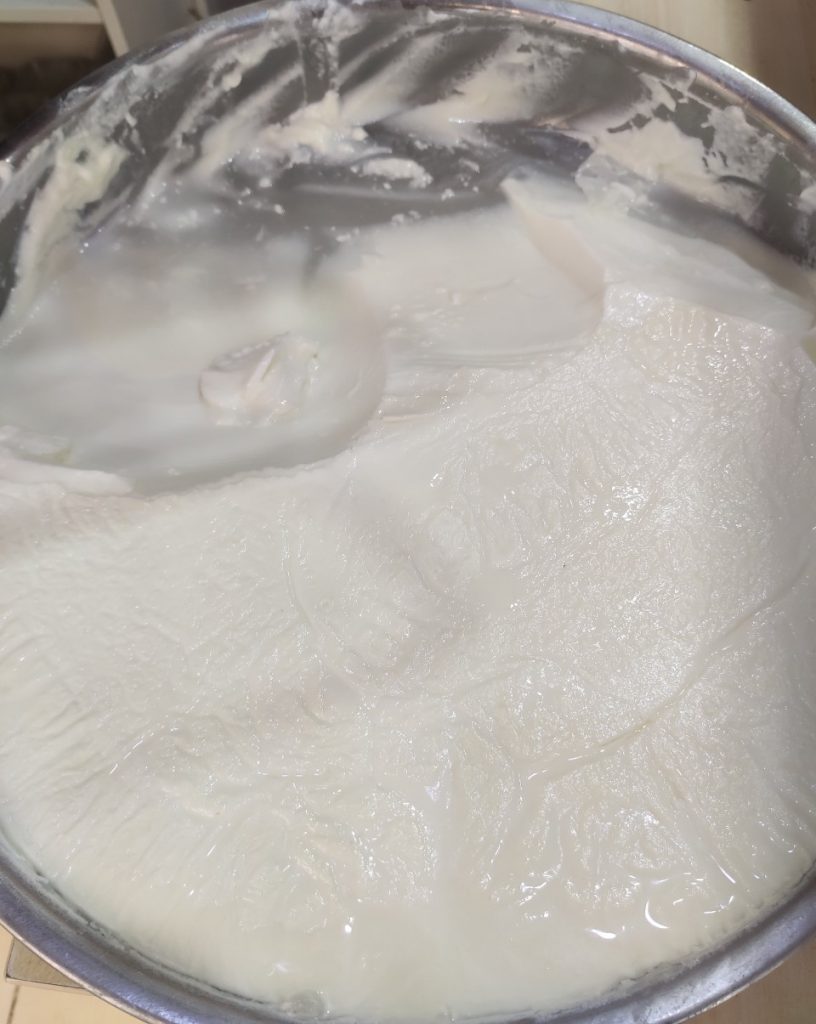Last week, my husband brought home a 5-liter bag of raw milk. He secretly stuck it in the refrigerator and then surprised me by saying, “Let’s make yogurt!” This is our version of a perfect night together – and don’t you dare judge us!
In our kitchen, eggs, nuts, and yogurt are the three most essential ingredients that we must have at all times. If these are stocked, we can get through a day feeling nourished and satisfied.
Before moving to Turkey, I probably would not have put yogurt on my “shortlist” but after nearly three years of living here, Turkish yogurt has transformed me. We mix it, scoop it and plop it on everything. When we are about to sit down for dinner, the most consistent refrain is, “Can you grab the yogurt?”

Over the past couple of months, my husband and I have perfected our yogurt recipe. We like to buy Jersey milk from our favorite gourmet food shop in Izmir, Bilge Çiftliği, then pour the milk into a big pot on the stove. We bring the milk to a boil and let it cool for 30 minutes or until you can hold your finger in for 10 seconds. To get it started, we take a generous spoonful from the last batch of yogurt, or from the storebought brands and mix until fully incorporated. We then put the lid on, and put it in the oven with just the oven light on (don’t actually turn on the heat!) and leave it in there for one day. Sometimes there is a bit more liquid than we like so we leave the pot of yogurt in the refrigerator without the lid for one to two days until it has firmed up.
Throughout the week, we eagerly pull out the cold, metal yogurt pot from the refrigerator, break through the clotted cream-like layer on top and enthusiastically plop the yogurt on the plate. My favorite way to adorn the yogurt is with a drizzle of olive oil, a squeeze of lemon and a sprinkle of crunchy Maldon salt. As soon as we can see the bottom of the yogurt pot peeking through, we immediately begin to prepare our next batch.
Of course, there are times when we can’t manage to fit yogurt making into our busy schedules. When we are not making our own yogurt, our go-to store bought brands are Tire and Foca which come in round plastic tubs of the dense and creamy yogurt. I have never experienced a yogurt quite like it while living in America – the thick consistency, tangy flavor, and unctuous mouthfeel are unique characteristics to Turkish yogurt. Unlike most yogurt in America, Turkish yogurt stands up proud and steady – you can take a knife and cut out sections of the delicacy. In Turkey, yogurt has more opportunities to augment culinary preparations and is not limited to just breakfast-time granola and berries. Turkish yogurt is paired with slices of delicious meat, topped on noodle dumplings, mantı, and mixed with delicious vegetable mezes. Yogurt can easily make or break the meal.
On a personal note, if there was a food that embodied my experience of living abroad in Turkey, it would be yogurt. It is a food from my diet while in America yet so very different in its uses and preparation here in Turkey. Much like my adjustment abroad, the tangy flavor and use in savory dishes were somewhat familiar but still something I had to get used to. It took me time to develop my palate and get comfortable with how to use the ingredient. Of course, my knowledge of yogurt and my experience of life abroad both improved significantly once my Turkish husband came into my life. I can keep this metaphor going but I think you get the point – Turkish yogurt makes all things better.
What makes this yogurt better, *cough* I mean different? Well, I suppose that is subjective. But the texture, quality of ingredients and respect given to the production of yogurt all lead to a product that is vital to the Turkish kitchen and that has been nearly perfected by Turkish food culture.
Perhaps before reading this article, you thought you did not speak of word of Turkish. But did you know that the word “yogurt” comes from the Turkish verb “yoğurmak,” which means to knead or mold? The roots of yogurt are generally traced back to the presence of fermentation which can be seen in both the Bible as well as early Roman texts. It is believed that the nomadic people of Central Asia experimented with boiled milk in animal skins to preserve the milk in the summer heat. Then the practice spread: “Turks migrating west and south from Central Asia introduced the milk fermentation process to Anatolia, the Caucasus, Russia, and the countries of East and Central Europe, as well as China and India. In these countries, the favorable climatic and environmental conditions for animal husbandry allowed increased production of yogurt’s raw material, milk.”(1) While no one nation or people group can take full credit for the creation of yogurt, this happy accident of fermented milk led a delicacy vital to so many food cultures.

It is also important to quickly discuss the similarities and confusion between Greek and Turkish yogurt. Yogurt is certainly not the only shared food between the Greek and Turkish food culture. Baklava, dolma, coffee, olive oil, tzatziki or cacık, papoutsakia or karnıyarık – this is a shortlist of the foods that represent both Greek and Turkish gastronomic culture. Despite these shared food cultures, the marketing of these food items in foreign countries, particularly in the West, has been slanted towards Greek representation. For example, let’s look at Chobani – a very large yogurt brand headquartered in America. While they advertise as Greek yogurt, the founder is from Turkey. The company name, Chobani, is derived from a Turkish word, çoban, meaning shepherd. While the presence of thick and high-fat yogurt is present in many food cultures, it is certainly challenging to see a company advertise as Greek even though the roots of the CEO’s yogurt history originate in Turkey. While I am not naive about the motivations of business and corporations, I do feel disappointed when Turkish food culture continues to be underrepresented or confused in international markets.
There really is something special about how yogurt is produced and utilized on this side of the Aegean. The universality of yogurt in many Middle Eastern cultures has yet to catch on in American food preparation but I believe things are starting to change. Replacing eggs with yogurt in baking recipes and switching sour cream for yogurt atop baked potatoes is just the beginning – clearing a path for the yogurt invasion around the world!
I desire to a part of spreading the news of the versatility of yogurt as well as the deep cultural history of yogurt in Central Asia and the Middle East. But don’t just take my personal yogurt conversion testimony as truth. I wish to inspire you to make your own batch of homemade yogurt (read above) and even try to use it in a new and unexpected way.
1. http://www.turkish-cuisine.org/malzemeler-ve-urunler-7/turk-mutfagina-has-urunler-68/yogurt-88.html
Default image courtesy of Tas Anjarwalla.
This article was originally published on 2020, by Jocette Lee.










